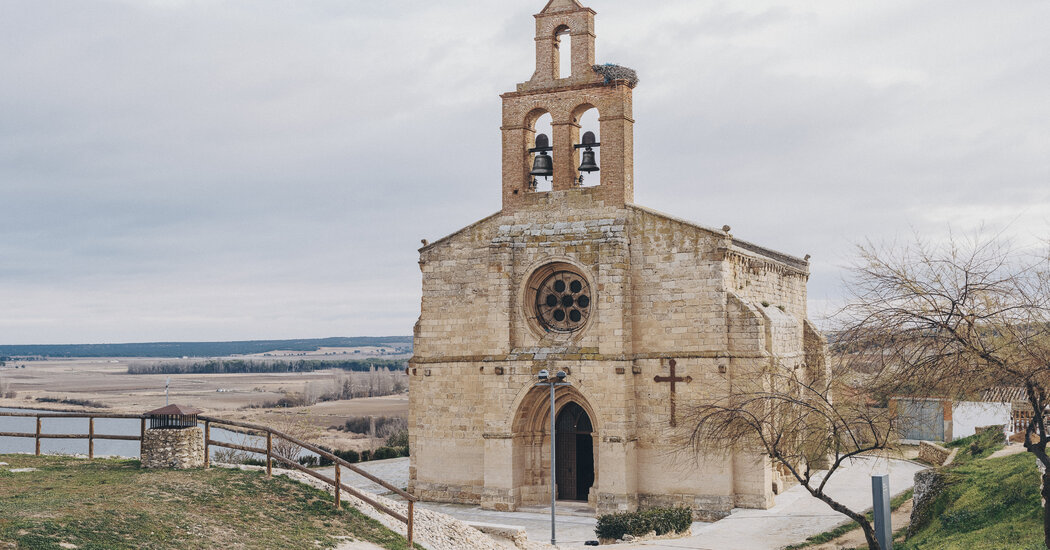
CASTRONUÑO, Spain — The Romanesque church that sits above the river in the Spanish village of Castronuño used to look like many others that dot the land: not too decrepit for a 750-year-old, but not particularly well-kept either.
Then in November, Mayor Enrique Seoane noticed something that gave him a shock and caused a scandal in Spain.
In a photo taken by one of his neighbors, Mr. Seoane spied a seam of very modern cement that someone had poured into a decidedly ancient archway. It was an apparent homemade repair job to keep the church’s eastern flank from falling in.
The work was done by an unknown “masked restorer,” the mayor told a local journalist in a story that soon spread across Spain.
While this might conjure visions of a superhero secretly coming to the aid of an aging church, that is not how the mayor’s words played in Spain. Instead, they stirred up bad memories in a country whose small towns and villages had been scarred before by the eyesores these sort of vigilante repair efforts leave behind.
The figure of do-gooder gone bad was epitomized in Spain by Cecilia Giménez, a grandmother then in her 80s, who made headlines around the world after her botched restoration of a century-old fresco of Jesus crowned with thorns called “Ecce Homo.” The result was so bungled, authorities at first thought the painting had been vandalized.
Spain’s art and architecture conservators vowed to stop these amateur, and unwanted, restorers.
Yet in Castronuño, in Valladolid Province northwest of Madrid, a mysterious someone had struck again, this time at the Church of Santa María del Castillo, built around 1250 by the Knights Hospitallers of St. John of Jerusalem.
Miguel Ángel García, the spokesman for the Valladolid Province Heritage Association, a small consortium of local residents who try to prevent this kind of travesty, among its other conservation efforts, had come for a look at the damage on a recent chilly evening. He gazed up at the cement, ruefully, as wind blew through a stork’s nest in the church’s bell tower.
“The story of the ‘Ecce Homo’ just keeps repeating itself all over the country,” he said.
It could be said that the problem of Castronuño is the problem of Spain: This ancient land just has too many old things in need of fixing. There are Phoenician forts, Celtic castles, Moorish minarets, Roman ramparts, granite Greek graves — all left by bygone civilizations that came here conquering, all bent on leaving something for posterity.
Even the name of the Spanish heartland, Castille, means something like “land of castles,” since so many were built after 800 years of battles between Christian and Muslim rulers.
As she stood outside Castronuño’s damaged church on a recent day, Mar Villarroel, a children’s book writer who doubles as the hamlet’s part-time tourism promoter, observed that if Spain’s blessing was that it had so much history, then its curse was that so much was at risk of being lost for neglect.
Take the old castle, she said, for which the village had been named, but that had been razed by Ferdinand II of Aragón in the time of Columbus. Or Castronuño’s first church — built even earlier than the one in use today, but demolished in 1919 (decades after its roof had fallen in).
More recently, the villagers had been begging the government and the local Roman Catholic Archdiocese to come fix Santa María del Castillo before it suffered a similar fate.
But with no sign that any help was on the way, someone was moved to take matters into their own grossly misguided hands.
“The cement is a scandal, it is ugly, yes,” Ms. Villarroel said. “But you want to know the real scandal? It’s that those in charge let the church get this way.”
José Antonio Conde, a kind of church caretaker called a sacristan, was trying to find the key on a recent evening. Only four people had copies, he said, and at least three seemed to be out of town. Finally, a sister of one picked up the phone. He darted off to find her.
Minutes later, he swung open the old creaky door. The church was nearly dark, and as eyes adjusted to the dim, the interior came slowly into view: a long nave, an old stone roof and a crucifix at the altar in front of a red drape. The large river stones that had been hauled up the hill during construction had each been signed with the mark of the ancient mason who had cut them.
Mr. Conde found the light switch, and the rest of the church was suddenly visible.
The damage couldn’t have been more clear. Years of water seeping into the walls from outside had left long white mineral stains, giving the appearance of a cave’s interior.
The retablo, the grand shelves made of wood that sit behind the altar, had been professionally restored, but the moisture was threatening them again. It was too late for the 18th-century frescoes that once showed scenes from the life of Jesus: Only one was fully visible, of Christ carrying the cross.
“You could still make them out when we were children,” said Manolo Brita, a friend of Mr. Conde’s, who had walked in behind him.
Mr. Conde, pointing up to the choir near the old rosette window, recalled a different memory from childhood, now many decades gone. “I remember when that choir was filled with children,” he said. “It’s not now.”
And that absence, he said, was the real reason the church was crumbling: because the village’s population was dwindling and there were few left to look after it anymore. The population had fallen from more than 1,500 when he was young to around 860 today, part of a rural flight that has afflicted villages across Spain.
While the mayor’s report this fall of a “masked restorer” had set off angry calls for an investigation to find the culprit, information that surfaced later both complicated the whodunit and emphasized just how long these errant interventions had been plaguing the country.
A local resident, looking through an aging book about the churches of the region, noticed an image that showed the same seam of cement over the archway at least as early as 1999, when the survey had been published. With the crime apparently at least two decades old, it seemed there might be no finding out who did it.
Sitting in his office, Mr. Seoane, the mayor, said he regretted if his words had made people think there would be a manhunt for the culprit. But the fact that no one had noticed the cement had been there all those years was telling too, he said.
And it wasn’t just the mishandled cement repair job that was now causing people to do a double take. Who had installed the alarm system that seemed drilled into the ancient stone? Or the bulky electrical conduit that jutted out of one of the ancient windows? It appeared to have been there for years, mostly unnoticed.
And why was there wire mesh covering over the rosette window, and who had put it there?
The list of impromptu repair jobs now being noticed at the church all of a sudden seemed endless. But at least the botched cement job — and the mayor’s colorful if fictional description of the perpetrator’s appearance — had gotten everyone’s attention, enough that Mr. Seoane thought he might finally get the funding to fix the other items that needed repair.
“If we don’t get the job done this time,” he said, “I don’t think we ever will.”
José Bautista contributed reporting from Castronuño.







